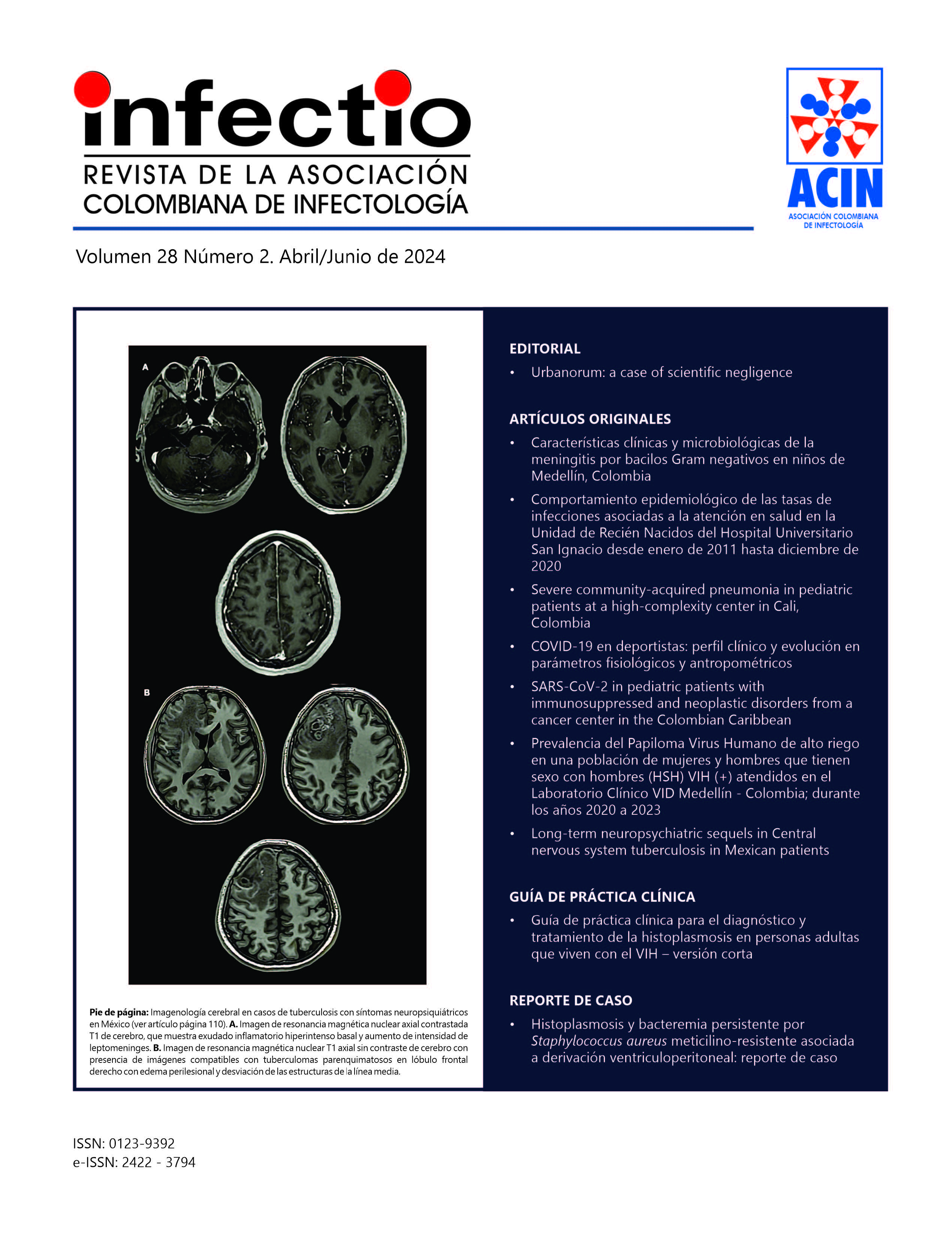Histoplasmosis y bacteremia persistente por Staphylococcus aureus meticilino-resistente asociada a derivación ventriculoperitoneal: reporte de caso
Contenido principal del artículo
Resumen
La histoplasmosis es una infección fúngica causada por Histoplasma ssp, que afecta principalmente el sistema respiratorio, mientras que Staphylococcus aureus resistente a la meticilina (SARM) es una bacteria notoria por ser resistente a los antibióticos y asociarse con infecciones graves. Presentamos un informe de caso de una mujer de 33 años con antecedente de hidrocefalia que se sometió a la colocación de una derivación ventriculoperitoneal (VP) y posteriormente fue llevada al servicio de urgencias debido a debilidad muscular progresiva y síntomas sugestivos de infección sistémica. Evaluaciones adicionales revelaron paquimeningitis, anomalías pulmonares y diagnósticos de histoplasmosis y bacteriemia por SARM que persistió durante varias semanas a pesar de la terapia antibiótica dirigida. La bacteriemia solo se resolvió después de que se retirara la derivación. Este caso resalta la importancia de considerar diversas etiologías, realizar investigaciones diagnósticas oportunas con un historial médico completo y adoptar enfoques de tratamiento adaptados para casos complejos que involucran infecciones concomitantes.
Detalles del artículo
Citas
Chong YP, Park SJ, Kim HS, Kim ES, Kim MN, Park KH, et al. Persistent Staphylococcus aureus Bacteremia. Medicine (Baltimore). 2013 Mar;92(2):98-108. DOI: https://doi.org/10.1097/MD.0b013e318289ff1e
Chang FY, MacDonald BB, Peacock JE, Musher DM, Triplett P, Mylotte JM, et al. A prospective multicenter study of Staphylococcus aureus bacteremia: incidence of endocarditis, risk factors for mortality, and clinical impact of methicillin resistance. Medicine (Baltimore). 2003 Sep;82(5):322-32. DOI: https://doi.org/10.1097/01.md.0000091185.93122.40
Yp C, Sj P, Hs K, Es K, Mn K, Kh P, et al. Persistent Staphylococcus aureus bacteremia: a prospective analysis of risk factors, outcomes, and microbiologic and genotypic characteristics of isolates. Medicine (Baltimore) [Internet]. 2013 Mar [cited 2022 Oct 31];92(2). Available from: https://pubmed.ncbi.nlm.nih.gov/23429353/. DOI: 10.1097/MD.0b013e318289ff1e
Risk Factors for Recurrent Staphylococcus aureus Bacteremia | Clinical Infectious Diseases | Oxford Academic [Internet]. [cited 2023 Feb 14]. Available from: https://academic.oup.com/cid/article/72/11/1891/5860449?login=false. DOI: https://doi.org/10.1093/cid/ciaa801
Maliniak ML, Stecenko AA, McCarty NA. A longitudinal analysis of chronic MRSA and Pseudomonas aeruginosa co-infection in cystic fibrosis: A single-center study. J Cyst Fibros. 2016 May 1;15(3):350-6. DOI: https://doi.org/10.1016/j.jcf.2015.10.014
Jia DT, Thakur K. Fungal Infections of the Central Nervous System. Semin Neurol. 2019 Jun;39(3):343-57. DOI: https://doi.org/10.1055/s-0039-1688916
Wheat LJ, Azar MM, Bahr NC, Spec A, Relich RF, Hage C. Histoplasmosis. Infect Dis Clin North Am. 2016 Mar;30(1):207-27. DOI: https://doi.org/10.1016/j.idc.2015.10.009
Staffolani S, Buonfrate D, Angheben A, Gobbi F, Giorli G, Guerriero M, et al. Acute histoplasmosis in immunocompetent travelers: a systematic review of literature. BMC Infect Dis. 2018 Dec 18;18(1):673. DOI: https://doi.org/10.1186/s12879-018-3476-z
Mehmood MA, Patel M, Sanekommu H. Methicillin-Resistant Staphylococcus Aureus: A Very Rare Cause of Meningitis. Cureus [Internet]. 2020 Sep [cited 2023 Mar 16];12(9). Available from: https://www.ncbi.nlm.nih.gov/pmc/articles/PMC7550032/. DOI: https://doi.org/10.7759/cureus.10370
Beh SC, Greenberg BM, Frohman T, Frohman EM. Transverse Myelitis. Neurol Clin. 2013 Feb;31(1):79-138. DOI: https://doi.org/10.1016/j.ncl.2012.09.008
Abrantes FF, Moraes MPM de, Rezende Filho FM, Pedroso JL, Barsottini OGP. A clinical approach to hypertrophic pachymeningitis. Arq Neuropsiquiatr. 2020 Dec;78(12):797-804. DOI: https://doi.org/10.1590/0004-282x20200073
Eisenhuber E. The Tree-in-Bud Sign. Radiology. 2002 Mar;222(3):771-2. DOI: https://doi.org/10.1148/radiol.2223991980
Connolly, P., Wheat, L. J., Schnizlein-Bick, C., Durkin, M., Kohler, S., Smedema, M., … Loebenberg, D. (2000). Comparison of a New Triazole, Posaconazole, with Itraconazole and Amphotericin B for Treatment of Histoplasmosis following Pulmonary Challenge in Immunocompromised Mice. Antimicrobial Agents and Chemotherapy, 44(10), 2604-2608. DOI: https://doi.org/10.1128/AAC.44.10.2604-2608.2000
Wheat, L. J. (2006). Activity of newer triazoles against Histoplasma capsulatum from patients with AIDS who failed fluconazole. Journal of Antimicrobial Chemotherapy, 57(6), 1235-1239. doi: https://doi.org/10.1093/jac/dkl133
Imai, J. K., Singh, G., Clemons, K. V., & Stevens, D. A. (2004). Efficacy of Posaconazole in a Murine Model of Central Nervous System Aspergillosis. Antimicrobial Agents and Chemotherapy, 48(10), 4063-4066. DOI: https://doi.org/10.1128/AAC.48.10.4063-4066.2004
Restrepo, A., Tobón, A., Clark, B., Graham, D. R., Corcoran, G., Bradsher, R. W., Goldman, M., Pankey, G., Moore, T., Negroni, R., & Graybill, J. R. (2007). Salvage treatment of histoplasmosis with posaconazole. The Journal of infection, 54(4), 319-327. https://doi.org/10.1016/j.jinf.2006.05.006
Schulze, A. B., Heptner, B., Kessler, T., Baumgarten, B., Stoica, V., Mohr, M., Berdel, W. E. (2017). Progressive histoplasmosis with hemophagocytic lymphohistiocytosis and epithelioid cell granulomatosis: A case report and review of the literature. European Journal of Haematology, 99(1), 91-100. DOI: https://doi.org/10.1111/ejh.12886
Clark, B., Foster, R., Tunbridge, A., & Green, S. (2005). A case of disseminated histoplasmosis successfully treated with the investigational drug posaconazole. Journal of Infection, 51(3), e177-e180. DOI: https://doi.org/10.1016/j.jinf.2005.01.001
Mazi, P. B., Arnold, S. R., Baddley, J. W., Bahr, N. C., Beekmann, S. E., McCarty, T. P., Polgreen, P. M., Rauseo, A. M., & Spec, A. (2022). Management of Histoplasmosis by Infectious Disease Physicians. Open forum infectious diseases, 9(7), ofac313. https://doi.org/10.1093/ofid/ofac313
Wheat, L. J., Freifeld, A. G., Kleiman, M. B., Baddley, J. W., McKinsey, D. S., Loyd, J. E., & Kauffman, C. A. (2007). Clinical Practice Guidelines for the Management of Patients with Histoplasmosis: 2007 Update by the Infectious Diseases Society of America. Clinical Infectious Diseases, 45(7), 807-825. doi: https://doi.org/10.1086/521259
Bobbili, K., Akram, S., Sundareshan, V., Prakash, V., Tyagi, I., Waqar, S., … Koirala, J. (2016). Comparison of Posaconazole and Itraconazole for treatment of Histoplasmosis. Open Forum Infectious Diseases, 3(suppl_1), 1646. doi: https://doi.org/10.1093/ofid/ofw172.1346
Mcclinton D, Carraccio C, Englander R. Predictors of ventriculoperitoneal shunt pathology. Pediatr Infect Dis J. 2001 Jun;20(6):593. DOI: https://doi.org/10.1097/00006454-200106000-00009
Stevens NT, Greene CM, O'Gara JP, Bayston R, Sattar MTA, Farrell M, et al. Ventriculoperitoneal shunt-related infections caused by Staphylococcus epidermidis: pathogenesis and implications for treatment. Br J Neurosurg. 2012 Dec 1;26(6):792-7. DOI: https://doi.org/10.3109/02688697.2011.651514
Paff M, Alexandru-Abrams D, Muhonen M, Loudon W. Ventriculoperitoneal shunt complications: A review. Interdiscip Neurosurg. 2018 Sep 1;13:66- 70. DOI: https://doi.org/10.1016/j.inat.2018.04.004
Mohsen S, Dickinson JA, Somayaji R. Update on the adverse effects of antimicrobial therapies in community practice. Can Fam Physician. 2020 Sep;66(9):651-9. PMID: 3293397

